ECU TOYOTA TUNDRA 2002 1.G Owner's Guide
[x] Cancel search | Manufacturer: TOYOTA, Model Year: 2002, Model line: TUNDRA, Model: TOYOTA TUNDRA 2002 1.GPages: 299, PDF Size: 5.59 MB
Page 221 of 299
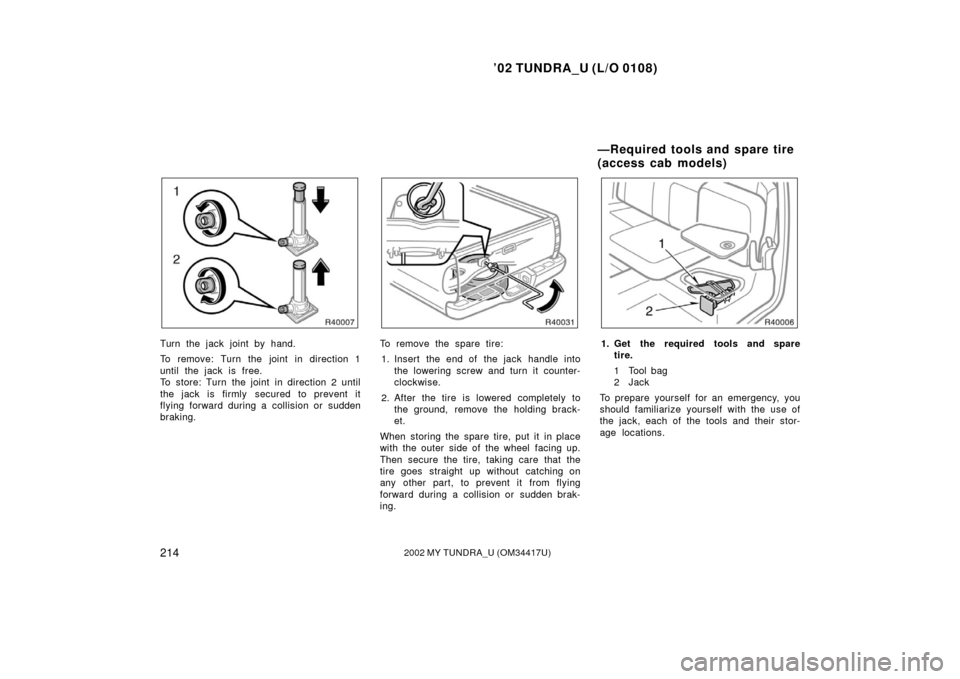
’02 TUNDRA_U (L/O 0108)
2142002 MY TUNDRA_U (OM 34417U)
Turn the jack joint by hand.
To remove: Turn the joint in direction 1
until the jack is free.
To store: Turn the joint in direction 2 until
the jack is firmly secured to prevent it
flying forward during a collision or s udden
braking.To remove the spare tire:
1. Insert the end of the jack handle into the lowering screw and turn it counter-
clockwise.
2. After the tire is lowered completely to the ground, remove the holding brack-
et.
When storing the spare tire, put it in place
with the outer side of the wheel facing up.
Then secure the tire, taking care that the
tire goes straight up without catching on
any other part, to prevent it from flying
forward during a collision or s udden brak-
ing.1. Get the required tools and spare tire.
1 Tool bag
2Jack
To prepare yourself for an emergency, you
should fam iliarize yourself with the use of
the jack, each of the tools and their stor-
age locations.
—Required tools and spare tire
(access cab models)
Page 222 of 299
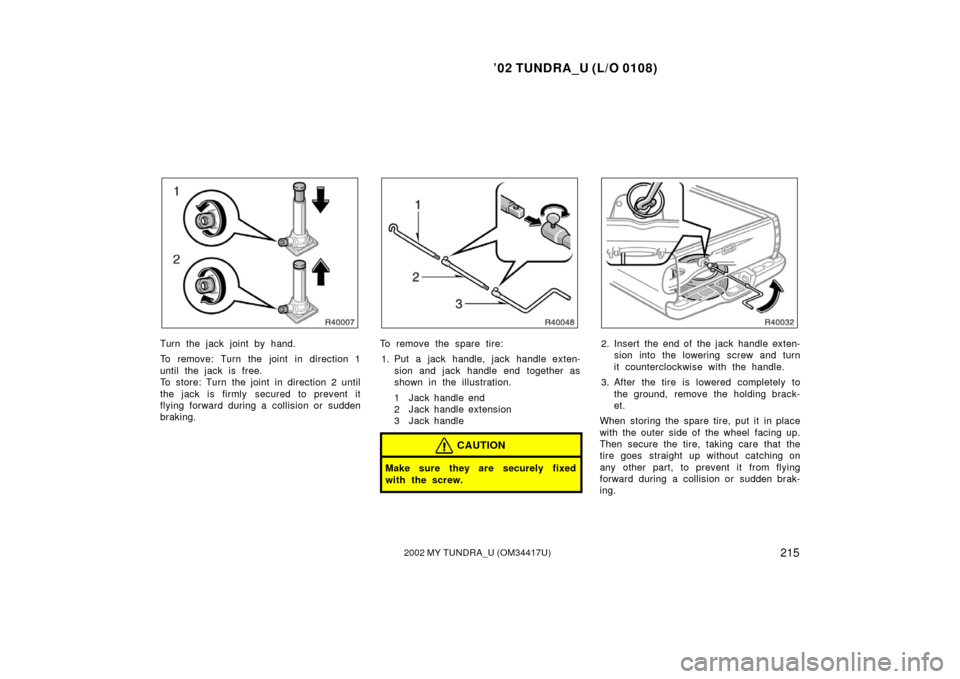
’02 TUNDRA_U (L/O 0108)
2152002 MY TUNDRA_U (OM 34417U)
Turn the jack joint by hand.
To remove: Turn the joint in direction 1
until the jack is free.
To store: Turn the joint in direction 2 until
the jack is firmly secured to prevent it
flying forward during a collision or s udden
braking.To remove the spare tire:
1. Put a jack handle, jack handle exten- sion and jack handle end together as
shown in the illustration.
1 Jack handle end
2 Jack handle extension
3 Jack handle
CAUTION
Make sure they are securely fixed
with the screw.
2. Insert the end of the jack handle exten-sion into the lowering screw and turn
it counterclockwise with the handle.
3. After the tire is lowered completely to the ground, remove the holding brack-
et.
When storing the spare tire, put it in place
with the outer side of the wheel facing up.
Then secure the tire, taking care that the
tire goes straight up without catching on
any other part, to prevent it from flying
forward during a collision or s udden brak-
ing.
Page 225 of 299
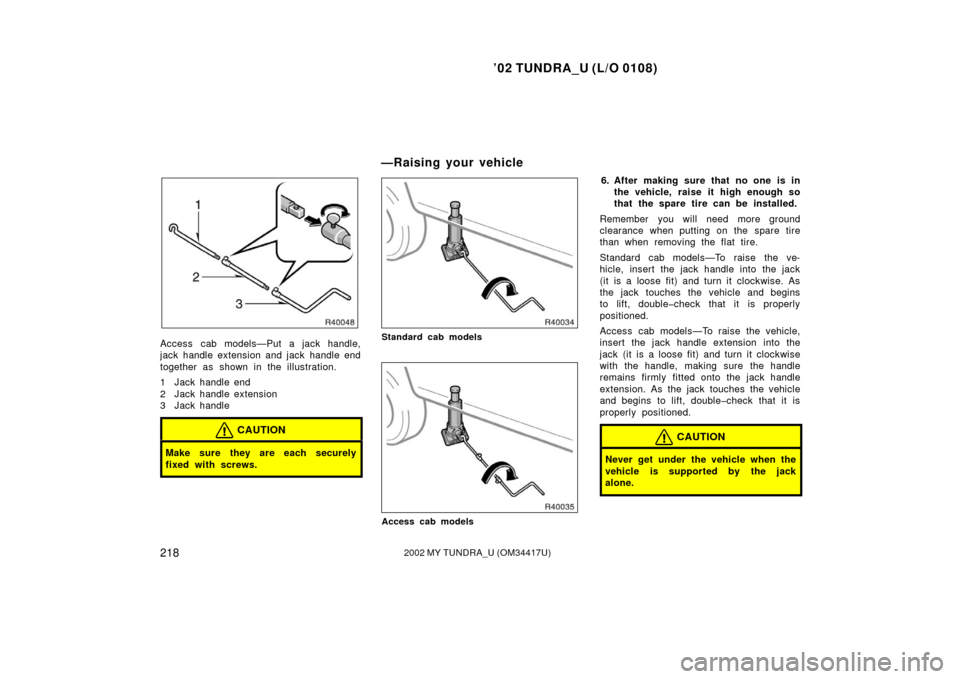
’02 TUNDRA_U (L/O 0108)
2182002 MY TUNDRA_U (OM 34417U)
Access cab models—Put a jack handle,
jack handle extension and jack handle end
together as shown in the illustration.
1 Jack handle end
2 Jack handle extension
3 Jack handle
CAUTION
Make sure they are each securely
fixed with screws.
Standard cab models
Access cab models
6. After making sure that no one is in
the vehicle, raise it high enough so
that the spare tire can be installed.
Remember you will need more ground
clearance when putting on the spare tire
than when removing the flat tire.
Standard cab models—To raise the ve-
hicle, insert the jack handle into the jack
(it is a loose fit) and turn it clockwise. As
the jack touches the vehicle and begins
to lift, double�check that it is properly
positioned.
Access cab models—To raise the vehicle,
insert the jack handle extension into the
jack (it is a loose fit) and turn it clockwise
with the handle, making sure the handle
remains firmly fitted onto the jack handle
extension. As the jack touches the vehicle
and begins to lift, double�check that it is
properly positioned.
CAUTION
Never get under the vehicle when the
vehicle is supported by the jack
alone.
—Raising your vehicle
Page 227 of 299
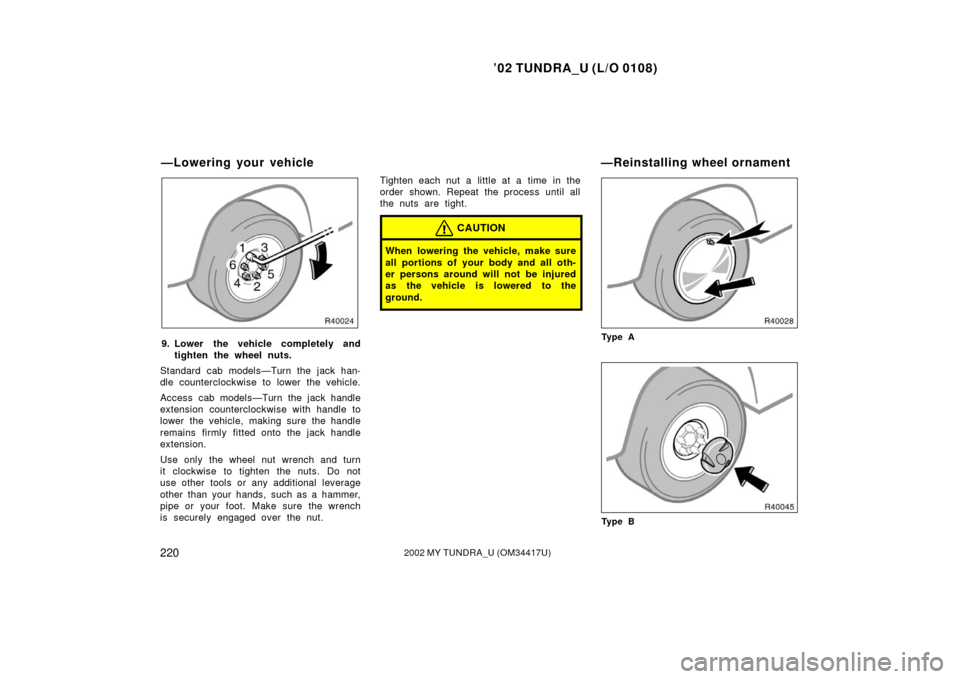
’02 TUNDRA_U (L/O 0108)
2202002 MY TUNDRA_U (OM 34417U)
9. Lower the vehicle completely and
tighten the wheel nuts.
Standard cab models—Turn the jack han-
dle counterclockwise to lower the vehicle.
Access cab models—Turn the jack handle
extension counterclockwise with handle to
lower the vehicle, making sure the handle
remains firmly fitted onto the jack handle
extension.
Use only the wheel nut wrench and turn
it clockwise to tighten the nuts. Do not
use other tools or any additional leverage
other than your hands, such as a hammer,
pipe or your foot. Make sure the wrench
is securely engaged over the nut. Tighten each nut a little at a time in the
order shown. Repeat the process until all
the nuts are tight.
CAUTION
When lowering the vehicle, make sure
all portions of your body and all oth-
er persons around will not be injured
as the vehicle is lowered to the
ground.
Ty p e A
Ty p e B
—Lowering your vehicle
—Reinstalling wheel ornament
Page 228 of 299
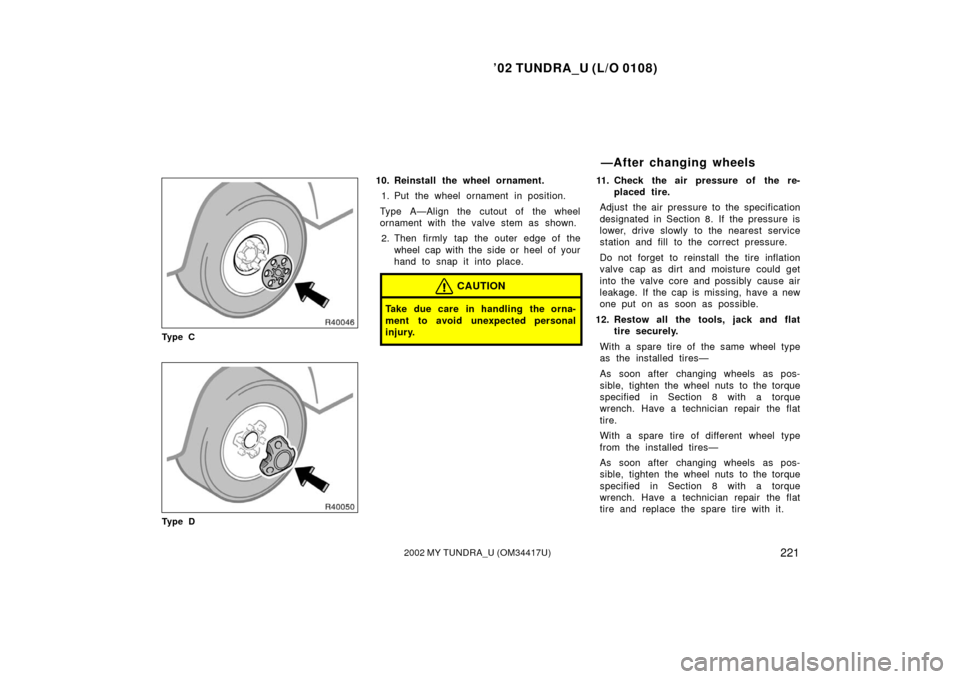
’02 TUNDRA_U (L/O 0108)
2212002 MY TUNDRA_U (OM 34417U)
Ty p e C
Ty p e D
10. Reinstall the wheel ornament.
1. Put the wheel ornament in position.
Type A—Align the cutout of the wheel
ornament with the valve stem as shown. 2. Then firmly tap the outer edge of the wheel cap with the side or heel of your
hand to snap it into place.
CAUTION
Take due care in handling the orna-
ment to avoid unexpected personal
injury.
11. Check the air pressure of the re- placed tire.
Adjust the air pressure to the specification
designated in Section 8. If the pressure is
lower, drive slowly to the nearest service
station and fill to the correct pressure.
Do not forget to reinstall the tire inflation
valve cap as dirt and moisture could get
into the valve core and possibly cause air
leakage. If the cap is missing, have a new
one put on as soon as possible.
12. Restow all the tools, jack and flat tire securely.
With a spare tire of the same wheel type
as the installed tires—
As soon after changing wheels as pos-
sible, tighten the wheel nuts to the torque
specified in Section 8 with a torque
wrench. Have a technician repair the flat
tire.
With a spare tire of different wheel type
from the installed tires—
As soon after changing wheels as pos-
sible, tighten the wheel nuts to the torque
specified in Section 8 with a torque
wrench. Have a technician repair the flat
tire and replace the spare tire with it.
—After changing wheels
Page 229 of 299
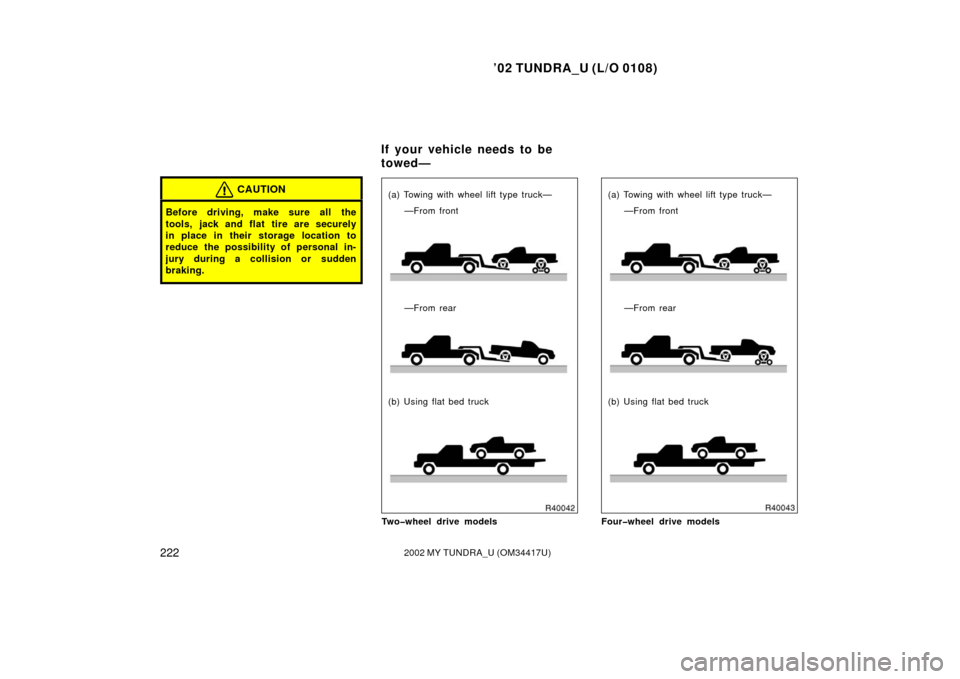
’02 TUNDRA_U (L/O 0108)
2222002 MY TUNDRA_U (OM 34417U)
CAUTION
Before driving, make sure all the
tools, jack and flat tire are securely
in place in their storage location to
reduce the possibility of personal in-
jury during a collision or s udden
braking.
(a) Towing with wheel lift type truck—
—From front
—From rear
(b) Using flat bed truck
Two�wheel drive models
(b) Using flat bed truck (a) Towing with wheel lift type truck— —From front
—From rear
Four�wheel drive models
If your vehicle needs to be
towed—
Page 232 of 299
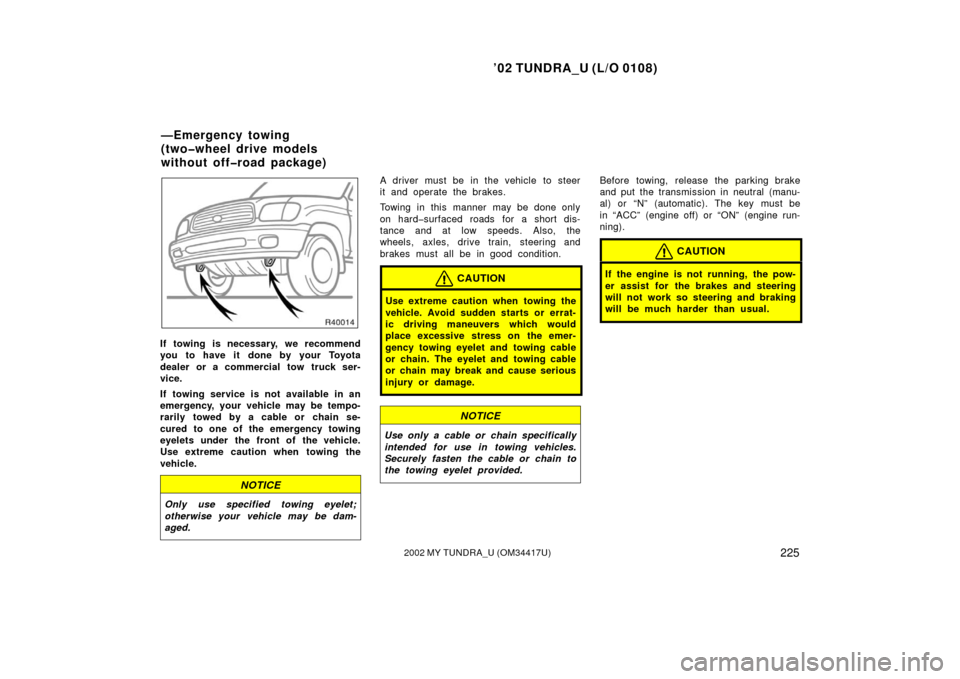
’02 TUNDRA_U (L/O 0108)
2252002 MY TUNDRA_U (OM 34417U)
If towing is necessary, we recommend
you to have it done by your Toyota
dealer or a commercial tow truck ser-
vice.
If towing service is not available in an
emergency, your vehicle may be tempo-
rarily towed by a cable or chain se-
cured to one of the emergency towing
eyelets under the front of the vehicle.
Use extreme caution when towing the
vehicle.
NOTICE
Only use specified towing eyelet;
otherwise your vehicle may be dam-
aged.
A driver must be in the vehicle to steer
it and operate the brakes.
Towing in this manner may be done only
on hard�surfaced roads for a short dis-
tance and at low speeds. Also, the
wheels, axles, drive train, steering and
brakes must all be in good condition.
CAUTION
Use extreme caution when towing the
vehicle. Avoid sudden starts or errat-
ic driving maneuvers which would
place excessive stress on the emer-
gency towing eyelet and towing cable
or chain. The eyelet and towing cable
or chain may break and cause serious
injury or damage.
NOTICE
Use only a cable or chain specifically
intended for use in towing vehicles.
Securely fasten the cable or chain to
the towing eyelet provided.
Before towing, release the parking brake
and put the transmission in neutral (manu-
al) or “N” (automatic). The key must be
in “ACC” (engine off) or “ON” (engine run-
ning).
CAUTION
If the engine is not running, the pow-
er assist for the brakes and steering
will not work so steering and braking
will be much harder than usual.
—Emergency towing
(two�wheel drive models
without off�road p ackage)
Page 233 of 299
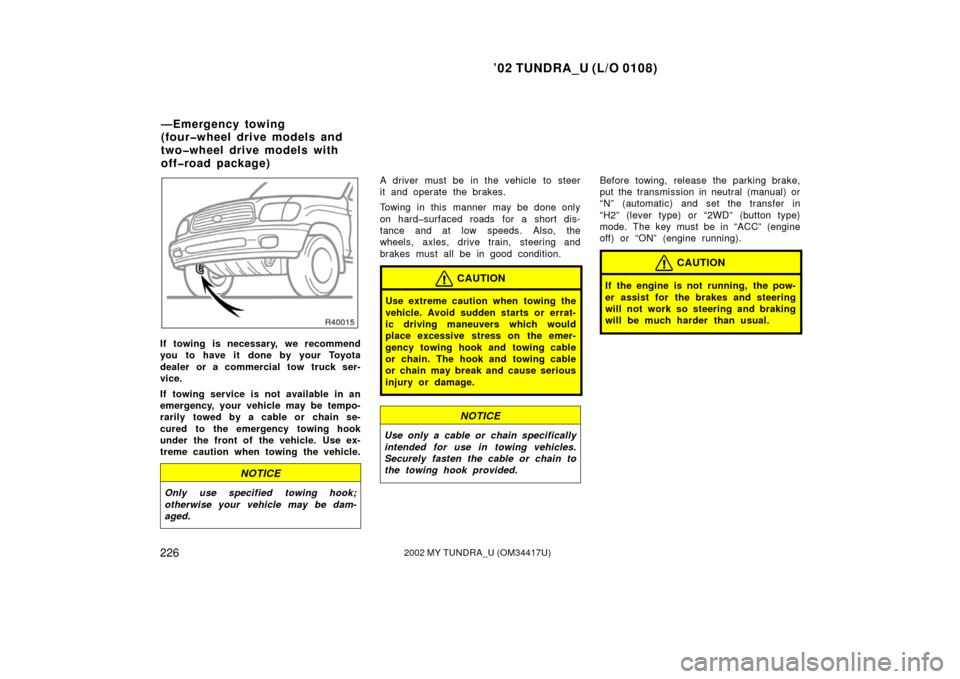
’02 TUNDRA_U (L/O 0108)
2262002 MY TUNDRA_U (OM 34417U)
If towing is necessary, we recommend
you to have it done by your Toyota
dealer or a commercial tow truck ser-
vice.
If towing service is not available in an
emergency, your vehicle may be tempo-
rarily towed by a cable or chain se-
cured to the emergency towing hook
under the front of the vehicle. Use ex-
treme caution when towing the vehicle.
NOTICE
Only use specified towing hook;
otherwise your vehicle may be dam-
aged.
A driver must be in the vehicle to steer
it and operate the brakes.
Towing in this manner may be done only
on hard�surfaced roads for a short dis-
tance and at low speeds. Also, the
wheels, axles, drive train, steering and
brakes must all be in good condition.
CAUTION
Use extreme caution when towing the
vehicle. Avoid sudden starts or errat-
ic driving maneuvers which would
place excessive stress on the emer-
gency towing hook and towing cable
or chain. The hook and towing cable
or chain may break and cause serious
injury or damage.
NOTICE
Use only a cable or chain specifically
intended for use in towing vehicles.
Securely fasten the cable or chain to
the towing hook provided.
Before towing, release the parking brake,
put the transmission in neutral (manual) or
“N” (automatic) and set the transfer in
“H2” (lever type) or “2WD” (button type)
mode. The key must be in “ACC” (engine
off) or “ON” (engine running).
CAUTION
If the engine is not running, the pow-
er assist for the brakes and steering
will not work so steering and braking
will be much harder than usual.
—Emergency towing
(four�wheel drive models and
two�wheel drive models with
off�road package)
Page 244 of 299
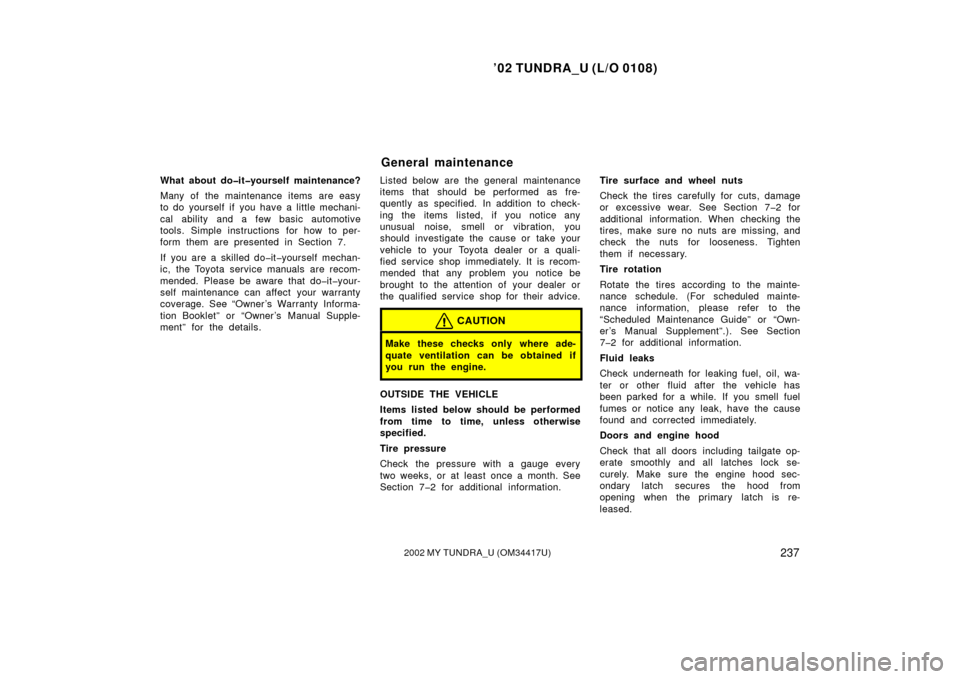
’02 TUNDRA_U (L/O 0108)
2372002 MY TUNDRA_U (OM 34417U)
What about do�it�yourself maintenance?
Many of the maintenance items are easy
to do yourself if you have a little mechani-
cal ability and a few basic automotive
tools. Simple instructions for how to per-
form them are presented in Section 7.
If you are a skilled do�it�yourself mechan-
ic, the Toyota service manuals are recom-
mended. Please be aware that do�it�your-
self maintenance can affect your warranty
coverage. See “Owner ’s Warranty Informa-
tion Booklet” or “Owner ’s Manual Supple-
ment” for the details. Listed below are the general maintenance
items that should be performed as fre-
quently as specified. In addition to check-
ing the items listed, if you notice any
unusual noise, smell or vibration, you
should investigate the cause or take your
vehicle to your Toyota dealer or a quali-
fied service shop immediately. It is recom-
mended that any problem you notice be
brought to the attention of your dealer or
the qualified service shop for their advice.
CAUTION
Make these checks only where ade-
quate ventilation can be obtained if
you run the engine.
OUTSIDE THE VEHICLE
Items listed below should be performed
from time to time, unless otherwise
specified.
Tire pressure
Check the pressure with a gauge every
two weeks, or at least once a month. See
Section 7�2 for additional information.Tire surface and wheel nuts
Check the tires carefully for cuts, damage
or excessive wear. See Section 7�2 for
additional information. When checking the
tires, make sure no nuts are missing, and
check the nuts for looseness. Tighten
them if necessary.
Tire rotation
Rotate the tires according to the mainte-
nance schedule. (For scheduled mainte-
nance information, please refer to the
“Scheduled Maintenance Guide” or “Own-
er ’s Manual Supplement”.). See Section
7�2 for additional information.
Fluid leaks
Check underneath for leaking fuel, oil, wa-
ter or other fluid after the vehicle has
been parked for a while. If you smell fuel
fumes or notice any leak, have the cause
found and corrected immediately.
Doors and engine hood
Check that all doors including tailgate op-
erate smoothly and all latches lock se-
curely. Make sure the engine hood sec-
ondary latch secures the hood from
opening when the primary latch is re-
leased.
General maintenance
Page 245 of 299

’02 TUNDRA_U (L/O 0108)
2382002 MY TUNDRA_U (OM 34417U)
INSIDE THE VEHICLE
Items listed below should be checked
regularly, e.g. while performing periodic
services, cleaning the vehicle, etc.
Lights
Make sure the headlights, stop lights, tail
lights, turn signal lights, and other lights
are all working. Check headlight aim.
Service reminder indicators and warning
buzzers
Check that all service reminder indicators
and warning buzzers function properly.
Steering wheel
Be alert for changes in steering condition,
such as hard steering or strange noise.
Seats
Check that all seat controls such as seat
adjusters, seatback recliner, etc. operate
smoothly and that all latches lock securely
in any position. Check that the head re-
straints move up and down smoothly and
that the locks hold securely in any latched
position. For folding�down seatback
(bench seat), check that the latches lock
securely. Seat belts
Check that the seat belt system such as
buckles, retractors and anchors operate
properly and smoothly. Make sure the belt
webbing is not cut, frayed, worn or dam-
aged.
Accelerator pedal
Check the pedal for smooth operation and
uneven pedal effort or catching.
Clutch pedal
Check the pedal for smooth operation.
Brake pedal
Check the pedal for smooth operation and
that the pedal has the proper clearance.
Check the brake booster function.
Brakes
At a safe place, check that the brakes do
not pull to one side when applied.
Parking brake (pedal type)
Check that the pedal has the proper travel
and that, on a safe incline, your vehicle
is held securely with only the parking
brake applied.
Parking brake (lever type)
Check that the lever has the proper travel
and that, on a safe incline, your vehicle
is held securely with only the parking
brake applied.
Automatic transmission “Park” mecha-
nism
On a safe incline, check that your vehicle
is held securely with the selector lever in
“P” position and all brakes released.
IN THE ENGINE COMPARTMENT
Items listed below should be checked
from time to time, e.g. each time when
refueling.
Washer fluid
Make sure there is sufficient fluid in the
tank. See Section 7�3 for additional in-
formation.
Engine coolant level
Make sure the coolant level is between
the “F” and “L” lines on the see�through
reservoir when the engine is cold. See
Section 7�2 for additional information.